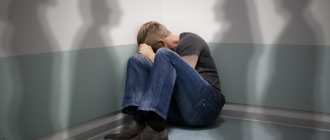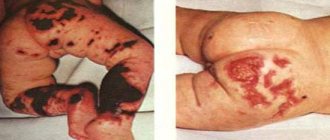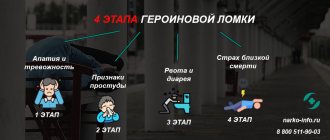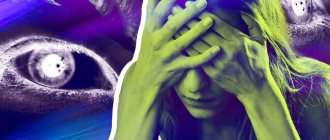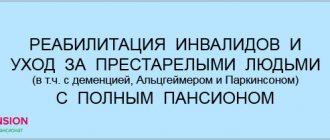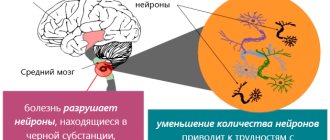Description
Pre-stroke is a temporary deterioration in blood supply to the brain (brain). The painful state of an impending stroke has a number of characteristic signs that can be used to identify a crisis and prevent it in advance. The body can turn on self-regulation mechanisms, thanks to which the symptoms disappear without a trace within 24 hours, and the functions of the brain are completely restored.
If circumstances are unfavorable and medical care is not provided, cerebrovascular accident can result in a stroke - hemorrhagic or ischemic. This condition in some cases leads to death.
Stroke (ICD-10 code – I63-I64) is characterized by an acute disruption of cerebral blood supply, usually leading to damage and death of nerve cells. Body functions corresponding to the affected areas simply disappear. A person may have problems with speech, memory, vision, movement, balance, swallowing, etc.
Types of strokes:
- hemorrhagic - occurs as a result of rupture of an intracerebral vessel, bleeding into the surrounding tissues, formation of a hematoma, pressing on nearby areas of the brain and causing disruption of their functioning;
- ischemic - appears as a result of blockage of a blood vessel by a thrombus, atherosclerotic plaque or embolus, while the blood supply to the brain area stops and necrosis occurs.
During a microstroke, only small areas of the brain are affected. The duration of the painful condition is from 5 minutes to several hours. In this situation, blood supply is disrupted only in the smallest vessels.
Stroke is an acute vascular accident in the brain. Lost functions may be restored after some time, or they may disappear forever. If a person shows signs of a pre-stroke, he urgently needs to provide first aid and call an ambulance.
Tactics for suspected pre-stroke condition
If the above symptoms appear, the first thing to do is call an ambulance. It is impossible to determine before hospitalization whether the symptoms that have developed are signs of a real stroke, or whether this is a pre-stroke condition.
While the ambulance is on the way, you need to:
- Lay the patient down, with the head slightly elevated (at an angle of about 30 degrees). At the same time, spare your neck as much as possible (do not bend it).
- Unbutton tight clothing.
- Try not to panic and calm the patient as much as possible.
- Blood pressure must be measured.
- If the numbers are very high, give a tablet of a fast-acting drug familiar to the patient (captopril, nifedipine). Strong blood pressure lowering drugs such as clonidine should not be given. The pressure should not be reduced sharply, but gradually, by 20-30%.
- 5-10 glycine tablets under the tongue or behind the cheek for resorption.
All suspicions of stroke and pre-stroke conditions require immediate hospitalization. In the hospital, it is possible to conduct special examinations to clarify the diagnosis, monitor the dynamics, and also select the correct treatment tactics. Even if the severe symptoms have regressed, you should not refuse hospitalization.
A transient cerebrovascular accident is a signal of serious trouble with the blood vessels of the brain, which in the end may not be able to withstand it and respond with a real catastrophe, often with irreversible consequences. Therefore, a pre-stroke condition is a wake-up call that requires you to completely reconsider your entire lifestyle to prevent stroke.
Causes
If a person shows signs of a pre-stroke condition, there are a number of reasons for this. These include: strong feelings, heavy physical activity, unhealthy lifestyle and bad habits. Most often, a pre-crisis situation is observed in patients with a number of serious pathologies. This group of patients belongs to the risk group, that is, to the category of people who need to be attentive to their health.
The following factors can precede a crisis:
- prolonged exposure to stress or severe nervous disorder;
- hard physical labor, overwork;
- addiction to alcohol and tobacco;
- uncontrolled use of medications;
- severe hypothermia or overheating of the body;
- non-compliance with diet, fatty, spicy foods, lack of fresh vegetables and fruits in the diet;
- changes in weather conditions, atmospheric pressure, magnetic storms, etc.
Risk group:
- hypertonic disease;
- obesity;
- diabetes;
- heart rhythm disturbance;
- high cholesterol;
- blood clotting disorder;
- sedentary or bedridden patients;
- advanced age;
- gender (crisis occurs more often in men than in women);
- genetic predisposition (parents have had a stroke or heart attack);
- psychosis, depression;
- migraine;
- atherosclerosis;
- vascular diseases;
- angina pectoris, heart attack, ischemic disease.
Stroke can occur at any age, even in young people suffering from a number of chronic diseases. If a girl, boy or child is at risk, they need to constantly monitor their well-being in order to recognize an approaching crisis. If pre-stroke signs appear, you should consult a doctor.
Symptoms
There are 2 types of transient cerebrovascular accident (TCI): transient ischemic attack (TIA) and cerebral hypertensive crisis. The symptoms of these two pre-stroke conditions are different.
TIA is the initial stage of an ischemic stroke. The reason is a narrowing or blockage of the artery that supplies the brain. The clinical picture of the condition depends on the vascular area in which the decrease in blood flow has occurred.
Acute hypertensive encephalopathy is an independent type of focal neurological disease when a pre-stroke occurs due to a sharp increase in blood pressure (BP). The blood pressure level in patients is high, it is equal to 180/120 or 200/140. In this condition, the circulatory network of the brain becomes filled with blood, and the permeability of the vessels increases and fluid passes through their walls.
Pre-stroke - main symptoms of TIA:
- numbness of the face and limbs;
- pallor;
- weakness;
- weakening of the pulse;
- facial asymmetry – one of the corners of the mouth goes down;
- speech disorder;
- stunned state;
- a person may not recognize acquaintances;
- vision problems: double vision, blurry pictures, loss of lateral vision;
- pain in the heart area;
- unilateral paresis of the limbs or individual muscle groups.
How to recognize a pre-stroke from the outside:
- the patient cannot smile;
- the mouth is curved on one side;
- it is difficult for a person to pronounce his name or repeat a phrase;
- speech is slurred and distorted;
- he cannot raise both arms up and keep them in a raised position due to weakness;
- If you ask to stick out a straight tongue, you won’t be able to do it; the organ will be curved.
Pre-stroke condition - the first symptoms of a hemorrhagic stroke:
- a sharp increase in blood pressure;
- headache bursting from the inside, which begins in the back of the head;
- nausea and vomiting;
- loss of strength, sometimes psychomotor agitation;
- difficulty breathing;
- flashing spots before the eyes;
- clouding of consciousness;
- increased sweating;
- the face becomes red or pale;
- involuntary movements;
- convulsions;
- fainting.
Pre-stroke - symptoms and first signs of the condition in women:
- dizziness;
- facial asymmetry;
- drooping lip;
- weakness of one half of the body;
- blurred vision;
- irritability and tearfulness;
- speech problems;
- clouding of consciousness.
Pre-stroke - symptoms and first signs of the condition in men:
- headache;
- numbness of the limbs and face;
- feeling of weakness;
- deterioration of health;
- impaired coordination and movement;
- stun;
- slurred speech.
Hemorrhagic stroke develops rapidly. Its main symptoms are a sharp headache, as if after a blow, and a short-term loss of consciousness. It occurs against the background of a hypertensive crisis.
Ischemic stroke develops gradually with atherosclerosis or acutely during blockage of a blood clot. The patient experiences numbness in the limbs, curvature of one side of the face, stupor, stupor and clouding of consciousness. Symptoms are precursors to a dangerous condition and must be responded to immediately, that is, call an ambulance.
Manifestations not related to the neurological sphere
- Menstrual irregularities due to dysfunction of the central nervous system (relevant for people under 50 years of age).
The central nervous system regulates endocrine processes, the production of hormones, and the beginning of monthly changes in a woman’s body depends on the concentration of specific substances.
An acute process can interrupt or delay menstruation.
- Depressive states. Psychiatric disorder.
- Apathy.
- Weakening of digestive processes.
The key symptom of pre-stroke in women is headache. It is layered with weakness, fatigue, asthenia, loss of consciousness and other manifestations. Cupping is always carried out in a hospital. The patient cannot be helped at home.
First aid
If a person has signs of a pre-stroke condition, it is necessary to urgently seek help from medical professionals. After a few minutes, the symptoms may go away on their own, but you need to wait for the doctors to arrive and undergo an examination. It is impossible to treat the victim at home with folk remedies. Before the ambulance arrives, the patient can only be given first aid.
First aid for pre-stroke:
- provide the patient with a horizontal position;
- raise your head a little, put a pillow under it;
- do not bend your neck;
- unbutton tight clothes;
- open the windows in the room to bring in fresh air;
- calm the patient;
- when vomiting, turn your head to the side;
- measure the temperature, if high, give an antipyretic (Paracetamol);
- if possible, measure blood pressure;
- if blood pressure is high, give Captopril or Nifedipine;
- if there are no medications, then to reduce the tone you need to bandage the thumb of your left hand with an elastic band, hold for 2-3 minutes, vigorously rub the hand towards the fingertips;
- Place 2 Glycine tablets under your tongue.
Doctors who arrive on call will provide the patient with the necessary assistance and give an injection. If the condition is critical, the person is hospitalized in a hospital. If not, he will be prescribed treatment at home.
How to help the victim
It is absolutely impossible to treat pre-stroke and stroke at home, even if the first symptoms have disappeared on their own. Be sure to call an ambulance and provide first aid to your loved one. It consists of providing bed rest with the head slightly elevated on the pillow. You cannot bend your neck; any external things that impede breathing or blood flow (tie, tight collar) must be removed. Medications that can be given include antipyretics, blood pressure normalizers, and sedatives.
When the victim is admitted to the hospital, his condition is constantly monitored to prevent a stroke or recurrent attack. As medical support, he is prescribed medications that normalize blood pressure, have a positive effect on blood vessels and prevent the formation of blood clots. After discharge, a strict diet, giving up bad habits, and moderate physical activity are prescribed.
Diagnostics
To identify the causes of the pre-stroke condition, a thorough examination of the patient is carried out. Based on the diagnostic results, the person is prescribed a course of therapy.
Diagnostic methods:
- blood pressure measurement;
- general blood analysis;
- blood test for cholesterol and glucose levels;
- ECG;
- Ultrasound of the carotid arteries of the neck;
- CT and MRI – for obtaining images of the brain.
A CT scan is performed to determine the presence of hemorrhage. Based on the obtained image, the patient is diagnosed with pathology. MRI allows you to see the first structural changes in the brain. If a stroke is suspected, diagnosis is carried out within the first hour after the patient is admitted to the hospital.
How to check?
When the first signs appear, you should immediately call an ambulance. When the victim is taken to a medical facility, he is urgently examined using the following methods:
- Blood pressure monitoring.
- Laboratory blood analysis for general indicators, cholesterol, sugar levels.
- ECG.
- Doppler ultrasound.
- CT scan of the brain.
- MRI of the brain.
If a hemorrhagic lesion is suspected, computed tomography is considered the best way to detect hemorrhage. In subsequent stages of development of stroke damage to the brain, it is better to monitor changes in tissue functionality using MRI, since magnetic tomography best visualizes soft tissue structures, inflammation, and necrotic processes.
Treatment
Treatment of any disease, including pre-stroke, is carried out based on diagnostic results. Symptoms of TIA and hypertensive crisis may resolve on their own within a few minutes or hours. However, patients who experience pre-stroke conditions require medical care to prevent future strokes.
Main areas of treatment:
- preventing the risk of stroke;
- prescribing medications that reduce the likelihood of a stroke and prevent the formation of blood clots.
To reduce the risk of stroke, the patient needs to switch to a healthy diet, give up fatty foods, and replenish their diet with fresh fruits and vegetables. It is recommended to stop drinking alcohol and smoking, and get rid of bad habits. It is necessary to engage in moderate exercise daily and normalize your weight.
Medicines that reduce the risk of stroke:
- antiplatelet drugs are medications that prevent the formation of blood clots (Clopidogrel);
- anticoagulants - reduce the level of blood clotting, which leads to the disappearance of blood clots in the vessels (Warfarin, Dabigatran).
If during the examination a pathology is detected in the patient, he is prescribed treatment in order to normalize the function of the cardiovascular system, breathing, and reduce swelling of the brain. In case of ischemic attack, patients need to be treated with antiplatelet agents, anticoagulants, nootropics (Picamilon), neuroprotectors (Cavinton). Cerebrolysin, Actovegin, vitamin preparations, antioxidants and other medications that improve metabolism and tissue nutrition are used as therapy.
In case of a hypertensive crisis, drugs to lower blood pressure, diuretics, neuroprotectors, and vasoactive agents are prescribed. Often, in case of hemorrhagic stroke, surgery is performed in critical situations. In severe cases, the patient is sent immediately to intensive care.
The difference between a stroke and a microstroke
In some sources, a microstroke is otherwise called a transient cerebrovascular accident. A transient - in other words, a temporary disturbance - passes within a day and is more like overwork and the consequences of a stressful state. During a micro-stroke, a small number of brain structures undergo necrosis, and the consequences of this may not be immediately noticeable. However, with a full-blown stroke, many more brain structures die, which seriously affects the quality of life.
The signs of stroke and micro-stroke in men are similar, the difference is that with a micro-stroke they go away much faster. It is for this reason that men often do not receive the necessary treatment on time and experience relapses.
Expert opinion
Author: Andrey Igorevich Volkov
Neurologist, Candidate of Medical Sciences
A microstroke, in accordance with medical terminology, is usually called a minor stroke. It is characterized by the same clinical picture as a major stroke. Signs include headache, inability to follow simple directions, loss of sensation in extremities, inability to smile, stick out tongue, and slurred speech. The difference between a minor stroke is that the neurological damage is reversible. The volume of the lesion is assessed using the NIHSS scale.
Clinical manifestations disappear within 24 hours, but do not completely affect the blood vessels of the brain. With microstrokes, necrosis of a very small area of the brain is possible, which can only be diagnosed based on the results of MRI and computed angiography. These types of diagnostics are available at the Yusupov Hospital.
At the first symptoms, it is important to get into the “therapeutic window” (4 hours). When starting therapy during this period, according to research, treatment is most effective. In this case, the zone of brain necrosis is limited to a small area.
Among the first measures: intravenous thrombolytic therapy, support of oxygenation of brain tissue, blood pressure monitoring, heart rate correction, prevention of tongue retraction and the formation of bedsores.
Complications
Repeated pre-stroke can lead to the development of a full-fledged stroke. The consequences of a hemorrhagic crisis are always more severe than an ischemic one. The mortality rate for this condition is much higher. Even if the patient suffered a crisis and survived, he may remain in a vegetative state for a long time.
After a TIA or crisis, the patient’s memory, mental performance, and vision are impaired. A stroke often causes coma, paralysis or paresis of certain muscle groups. A severe stroke can cause death.
Stroke is a difficult experience
There are several types of stroke, differing in the causes of occurrence, the severity of brain damage and the complexity of the disease. Based on the mechanics of the onset and development of the disease, stroke is distinguished
- Ischemic;
- Hemorrhagic;
- Subarachnoid.
Brain damage can be widespread and local. An attack that lasts for 24 hours is called a transient stroke. The deterioration of the patient's condition over the course of 20 days develops into a minor stroke, the result of which can be an unexpected cerebral hemorrhage, as well as a relapse in the form of repeated strokes. Most often, the third attack becomes a critical point, after which there is no chance of life. Accordingly, three stages are characterized by the degree of the disease: mild, moderate and severe.
Prevention
To avoid negative consequences, you need to engage in stroke prevention. People suffering from hypertension or other vascular diseases need to avoid physical and emotional stress, adhere to a healthy diet, and lead an active lifestyle. Medicines should be taken only as prescribed by a doctor. Be sure to undergo regular examinations in the hospital, measure blood pressure and blood glucose levels.
If a person has suffered a stroke, he will need to undergo rehabilitation. For this purpose, the patient is prescribed physiotherapeutic procedures, therapeutic exercises, and special exercises to restore facial expressions and eliminate its asymmetry. To return to the patient’s previous speech, classes with a speech therapist or speech pathologist are necessary. Impaired intellect and memory are treated using special techniques (micropolarization, Tomatis).



